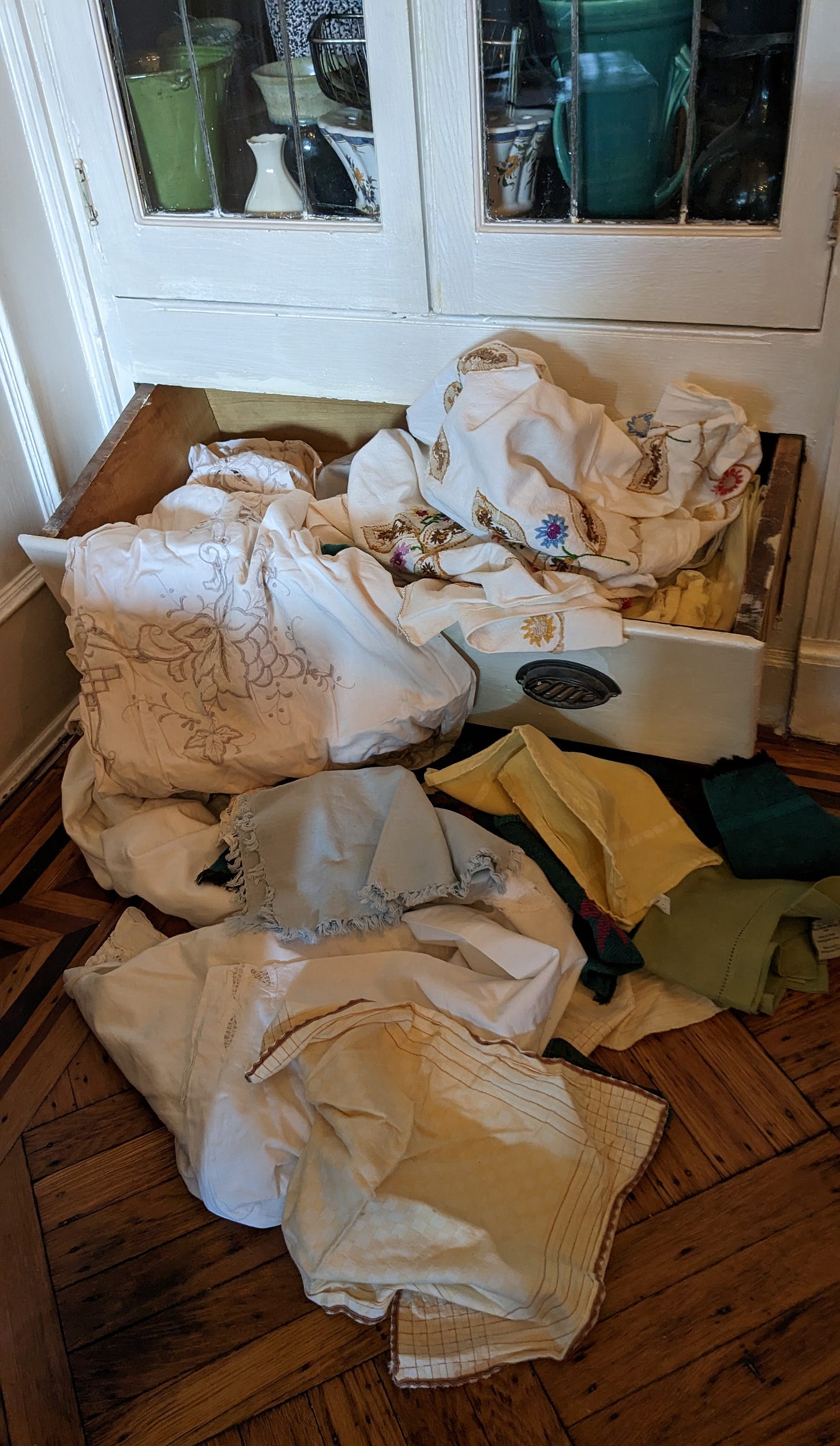Old Linens
Short stories printed on napkins and tablecloths.
The shallow bottom drawers of the dining room’s built-in china closets are jammed with table linens: six tablecloths, four sets of large dinner-size napkins, six sets of small luncheon-size napkins, and 11 tiny cocktail napkins. One three-yard square thing might be for a side table or buffet. The four-leaf clover-shaped one is supposed to line a biscuit basket. Two bar towels are knotted together. Except for a damask napkin set, they are all decorated with hardanger, cutwork, needlace, stumpwork, or crewel embroidery, the majority hand-stitched. One tablecloth with five matching napkins was inherited; the rest was discovered by friends when they cleaned out their parents’ houses after they died. They thought I would like and know how to use them.
There’s a simple reason for why someone might think their family heirlooms would be happy in my home. According to the teachings of my mom, who learned from her mom, who learned from years of service as a maid and cook in rich peoples’ homes, the universe would come to a full stop if the table was not properly dressed or the canapés and cocktails not served without the appropriately accompanied linens.
You’ll always find something interesting and kind of fun to read on America Eats! Best of all, it’s free and comes with a ton of gratitude for supporting one writer’s work.
If you have not had the privilege of learning life’s hard lessons passed down by the women in my family (and the linen one is way down low on their long list), then you may not have picked up the reason why linens have been replaced by placemats and runners. All those items listed above require such high maintenance that only a household of servants and dedicated housewives would put up with them. Caring for table linens begins by soaking them in bluing, then carefully rinsing out the bluing before a gentle wash. If they have extensive embroidery or lace, this must be done by hand. Drying on a clothesline in the sun helps whiten the cloths even further. After this comes the ironing and the folding in a precise manner that will retain their crispness. Finally, they are laid in a fragrant drawer as reverently as the shroud of Turin.
You are very right to suspect that the ones in my possession have been neglected for decades, shoved about and, mismatched and willy-nilly, bundled away. On the occasions when they are used, I pull out whatever is easiest to extract. Wrinkles are smoothed out with pressure from a dampened hand, usually an hour before they are needed. The horrified repremands of my mom and grandmom are defeaning.
A period of furious house-cleaning and purging is now taking place, with bags and bags of things that once seemed essential to life headed off to better places. The family set went back in and the whittling down commenced. Some were so fragile that the threads in the weave had frayed. The center panel of a long heavily cutwork tablecloth barely held together. Once neat rows of French knots tussled about.
And there were stains, strangely noted for the first time perhaps because I was preparing to send them away. Blots of gravy, pefect red wine circles, brown wiggles of dripped coffee or tea. An impression of lips on a cocktail napkin. Candle wax, holiday drips of red and green, birthday splatters of greens, blues, and silver. A sprinkling of small mysterious hard circles near the edges of a damask napkin on one. The shape of the letter “N” in faded blue ink on another. Chapters upon chapters filled with scenes of gaiety and delight and drama tumbled together, piled on my lap.
Generations of ghosts illustrated my family’s linens. Gatherings of feasts of joy or sadness, the mundane and the consequential. The cocktails brought to the table to finish before the bottles of wine opened and the cups upon cups of coffee and tea lingered over so the parties would not end. The laughter, oh the laughter!, and disagreements, and decisions. The memories of my mom on Mondays pinning the long cloth and napkins to the laundry line strung across the yard. How she pulled the white fabric taut, watched them catch like sails and glide across the grass and flower bed and then going on with the rest of her Monday cleaning. The instructions given to her daughters after they came home from school about not to just dropping them into the basket but folding them as we took them down. The board brought into the dining room, her starching and steaming and slamming the iron lightly across each beautiful tablecloth and napkin while directing her children’s homework and melodramas staged on the bare dining room table.
Yesterday morning, I soaked all the linens in bluing and gently washed them, then gingerly pinned them on a line that sagged across the yard in the sun. Late in the afternoon on a cushion of towels atop the dining room table I starched and ironed each piece into precise folds so that when laid once more in the china closets’ drawers the tablecloths and napkins would retain their crispness until they were brought out and used again.
Love you all!~P




You honestly got me through raising my kids with
Pie Everyday
Thank you!❤️
I can’t find bluing anywhere in my town. I was on a hunt a few months back and no place, not even our general store that has everything, had it. 🙁